Lockheed Corporation
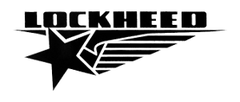 | |
| Industry | Aerospace |
|---|---|
| Fate | Merged with Martin Marietta |
| Successor | Lockheed Martin |
| Founded | 1926 |
| Defunct | 1995 |
| Headquarters | Calabasas, California[1] |
| Products | Aircraft |
The Lockheed Corporation was an American aerospace company. Lockheed was founded in 1926 and later merged with Martin Marietta to form Lockheed Martin in 1995. The founder, Allan Lockheed, had earlier founded the similarly named but otherwise unrelated Loughead Aircraft Manufacturing Company, which was operational from 1912 through 1920.
History
Origins
Allan Loughead and his brother Malcolm Loughead had operated an earlier aircraft company, Loughead Aircraft Manufacturing Company, which was operational from 1912 to 1920.[2] The company built and operated aircraft for paying passengers on sightseeing tours in California and had developed a prototype for the civil market, but folded in 1920 due to the flood of surplus aircraft deflating the market after World War I. Allan went into the real estate market while Malcolm had meanwhile formed a successful company marketing brake systems for automobiles.[3]
In 1926, Allan Lockheed, John Northrop, Kenneth Kay and Fred Keeler secured funding to form the Lockheed Aircraft Company in Hollywood (the spelling was changed phonetically to prevent mispronunciation).[4] This new company utilized some of the same technology originally developed for the Model S-1 to design the Vega Model. In March 1928, the company relocated to Burbank, California, and by year's end reported sales exceeding one million dollars. From 1926-28 the company produced over 80 aircraft and employed more than 300 workers who by April 1929 were building five aircraft per week. In July 1929, majority shareholder Fred Keeler sold 87% of the Lockheed Aircraft Company to Detroit Aircraft Corporation. In August 1929, Allan Loughead resigned.
The Great Depression ruined the aircraft market, and Detroit Aircraft went bankrupt. A group of investors headed by brothers Robert and Courtland Gross, and Walter Varney, bought the company out of receivership in 1932. The syndicate bought the company for a mere $40,000 ($660,000 in 2011). Ironically, Allan Loughead himself had planned to bid for his own company, but had raised only $50,000 ($824,000), which he felt was too small a sum for a serious bid.[5]
In 1934, Robert E. Gross was named chairman of the new company, the Lockheed Aircraft Corporation, which was headquartered at what is now the airport in Burbank, California. His brother Courtlandt S. Gross was a co-founder and executive, succeeding Robert as Chairman following his death in 1961. The company was named the Lockheed Corporation in 1977.
The first successful construction that was built in any number (141 aircraft) was the Vega first built in 1927, best known for its several first- and record-setting flights by, among others, Amelia Earhart, Wiley Post, and George Hubert Wilkins. In the 1930s, Lockheed spent $139,400 ($2.29 million) to develop the Model 10 Electra, a small twin-engined transport. The company sold 40 in the first year of production. Amelia Earhart and her navigator, Fred Noonan, flew it in their failed attempt to circumnavigate the world in 1937. Subsequent designs, the Lockheed Model 12 Electra Junior and the Lockheed Model 14 Super Electra expanded their market.
Prewar production
The Lockheed Model 14 formed the basis for the Hudson bomber, which was supplied to both the British Royal Air Force and the United States military before and during World War II.[6][7] Its primary role was submarine hunting. The Model 14 Super Electra were sold abroad, and more than 100 were license-built in Japan for use by the Imperial Japanese Army.[8]
Production during World War II
At the beginning of World War II, Lockheed – under the guidance of Clarence (Kelly) Johnson, who is considered one of the best-known American aircraft designers – answered a specification for an interceptor by submitting the P-38 Lightning fighter aircraft, a twin-engined, twin-boom design. The P-38 was the only American fighter aircraft in production throughout American involvement in the war, from Pearl Harbor to Victory over Japan Day. It filled ground-attack, air-to-air, and even strategic bombing roles in all theaters of the war in which the United States operated. The P-38 was responsible for shooting down more Japanese aircraft than any other U.S. Army Air Forces type during the war; it is particularly famous for being the aircraft type that shot down Japanese Admiral Isoroku Yamamoto's airplane.[9][10]

The Lockheed Vega factory was located next to Burbank's Union Airport which it had purchased in 1940. During the war, the entire area was camouflaged to fool enemy aerial reconnaissance. The factory was hidden beneath a huge burlap tarpaulin painted to depict a peaceful semi-rural neighborhood, replete with rubber automobiles.[12][13] Hundreds of fake trees, shrubs, buildings, and even fire hydrants were positioned to give a three-dimensional appearance. The trees and shrubs were created from chicken wire treated with an adhesive and covered with feathers to provide a leafy texture.[9][14]
Lockheed ranked tenth among United States corporations in the value of wartime production contracts.[15] All told, Lockheed and its subsidiary Vega produced 19,278 aircraft during World War II, representing six percent of war production, including 2,600 Venturas, 2,750 Boeing B-17 Flying Fortress bombers (built under license from Boeing), 2,900 Hudson bombers, and 9,000 Lightnings.[16]
Postwar production
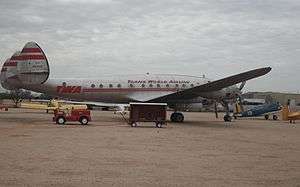
During World War II, Lockheed, in cooperation with Trans-World Airlines (TWA), had developed the L-049 Constellation, a radical new airliner capable of flying 43 passengers between New York and London at a speed of 300 mph (480 km/h) in 13 hours.
Once the Constellation (nicknamed Connie) went into production, the military received the first production models; after the war, the airlines received their original orders, giving Lockheed more than a year's head-start over other aircraft manufacturers in what was easily foreseen as the post-war modernization of civilian air travel. The Constellations' performance set new standards which transformed the civilian transportation market. Its signature tri-tail was the result of many initial customers not having hangars tall enough for a conventional tail. Lockheed produced a larger transport, the double-decked R6V Constitution, which was intended to make the Constellation obsolete. However, the design proved underpowered.
Skunk Works
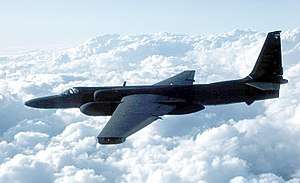
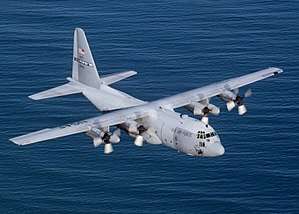
In 1943, Lockheed began, in secrecy, development of a new jet fighter at its Burbank facility. This fighter, the Lockheed P-80 Shooting Star, became the first American jet fighter to score a kill. It also recorded the first jet-to-jet aerial kill, downing a Mikoyan-Gurevich MiG-15 in Korea, although by this time the F-80 (as it was redesignated in June 1948) was already considered obsolete.[17]
Starting with the P-80, Lockheed's secret development work was conducted by its Advanced Development Division, more commonly known as the Skunk Works. The name was taken from Al Capp's comic strip Li'l Abner. This organization has become famous and spawned many successful Lockheed designs, including the U-2 (late 1950s), SR-71 Blackbird (1962) and F-117 Nighthawk stealth fighter (1978). The Skunk Works often created high-quality designs in a short time and sometimes with limited resources.
Projects during the Cold War
In 1954, the Lockheed C-130 Hercules, a durable four-engined transport, flew for the first time. This type remains in production today. In 1956, Lockheed received a contract for the development of the Polaris Submarine Launched Ballistic Missile (SLBM); it would be followed by the Poseidon and Trident nuclear missiles. Lockheed developed the F-104 Starfighter in the late 1950s, the world's first Mach 2 fighter jet. In the early 1960s, the company introduced the C-141 Starlifter four-engine jet transport.
During the 1960s, Lockheed began development for two large aircraft: the C-5 Galaxy military transport and the L-1011 TriStar wide-body civil airliner. Both projects encountered delays and cost overruns. The C-5 was built to vague initial requirements and suffered from structural weaknesses, which Lockheed was forced to correct at its own expense. The TriStar competed for the same market as the McDonnell Douglas DC-10; delays in Rolls-Royce engine development caused the TriStar to fall behind the DC-10. The C-5 and L-1011 projects, the cancelled U.S. Army AH-56 Cheyenne helicopter program, and embroiled shipbuilding contracts caused Lockheed to lose large sums of money during the 1970s.
Drowning in debt, in 1971 Lockheed (then the largest US defense contractor) asked the US government for a loan guarantee, to avoid insolvency. The measure was hotly debated in the US Senate. The chief antagonist was Senator William Proxmire (D-Wis), the nemesis of Lockheed and its chairman, Daniel J. Haughton. Following a fierce debate, Vice President Spiro T. Agnew cast a tie-breaking vote in favor of the measure (August 1971). Lockheed finished paying off the $1.4 billion loan in 1977, along with about $112.22 million in loan guarantee fees.[18]
Bribery scandals
The Lockheed bribery scandals were a series of illegal bribes and contributions made by Lockheed officials from the late 1950s to the 1970s. In late 1975 and early 1976, a subcommittee of the U.S. Senate led by Senator Frank Church concluded that members of the Lockheed board had paid members of friendly governments to guarantee contracts for military aircraft.[19] In 1976, it was publicly revealed that Lockheed had paid $22 million in bribes to foreign officials[20] in the process of negotiating the sale of aircraft including the F-104 Starfighter, the so-called Deal of the Century.[21][22]
The scandal caused considerable political controversy in West Germany, the Netherlands, Italy, and Japan. In the US, the scandal led to passage of the Foreign Corrupt Practices Act, and nearly led to the ailing corporation's downfall (it was already struggling due to the poor sales of the L-1011 airliner). Haughton resigned his post as chairman.[23]
Attempted leveraged buyout
In the late 1980s, leveraged buyout specialist Harold Simmons conducted a widely publicized but unsuccessful takeover attempt on the Lockheed Corporation, having gradually acquired almost 20 percent of its stock. Lockheed was attractive to Simmons because one of its primary investors was the California Public Employees' Retirement System (CalPERS), the pension fund of the state of California. At the time, the New York Times said, "Much of Mr. Simmons's interest in Lockheed is believed to stem from its pension plan, which is over financed by more than $1.4 billion. Analysts said he might want to liquidate the plan and pay out the excess funds to shareholders, including himself." Citing the mismanagement by its chairman, Daniel M. Tellep, Simmons stated a wish to replace its board with a slate of his own choosing, since he was the largest investor. His board nominations included former Texas Senator John Tower, the onetime chairman of the Armed Services Committee, and Admiral Elmo Zumwalt Jr., a former Chief of Naval Operations.[24][25] Simmons had first begun accumulating Lockheed stock in early 1989 when deep Pentagon cuts to the defense budget had driven down prices of military contractor stocks, and analysts had not believed he would attempt the takeover since he was also at the time pursuing control of Georgia Gulf.[26]
Timeline
- 1912: The Alco Hydro-Aeroplane Company established.
- 1916: Company renamed Loughead Aircraft Manufacturing Company.
- 1926: Lockheed Aircraft Company formed.
- 1929: Lockheed becomes a division of Detroit Aircraft.
- 1932: Robert and Courtland Gross take control of company after the bankruptcy of Detroit Aircraft. Company renamed Lockheed Aircraft Corporation, reflecting the company's reorganization under a board of directors.
- 1943: Lockheed's Skunk Works founded in Burbank, California.
- 1954: First flight of the Lockheed C-130 Hercules.
- 1954: Maiden flight of the Lockheed U-2.
- 1961: Grand Central Rocket Company acquired as Lockheed Propulsion Company.
- 1962: First flight of the A-12 Blackbird.
- 1964: First flight of the Lockheed SR-71 Blackbird.
- 1970 First flight of the L-1011 TriStar.
- 1976: The Lockheed bribery scandals.
- 1977: Company renamed Lockheed Corporation, to reflect non-aviation activities of the company.
- 1978: The company's Hollywood-Burbank Airport is sold to its nearby cities and becomes Burbank-Glendale-Pasadena Airport (later renamed Bob Hope Airport in 2003).[27]
- 1981: First flight of the F-117 Nighthawk.
- 1985: Acquires Metier Management Systems.
- 1986: Acquires Sanders Associates electronics of Nashua, New Hampshire.
- 1991: Lockheed, General Dynamics and Boeing begin development of the F-22 Raptor.
- 1992: All aerospace related activities end at the Burbank facility.
- 1993: Acquires General Dynamics' Fort Worth aircraft division, builder of the F-16 Fighting Falcon.
- 1995: Lockheed Corporation merges with Martin Marietta to form Lockheed Martin.
Divisions
Lockheed's operations were divided between several groups and divisions, many of which continue to operate within Lockheed [28]
Aeronautical Systems group
- Lockheed-California Company (CALAC), Burbank, California.
- Lockheed-Georgia Company (GELAC), Marietta, Georgia.
- Lockheed Advanced Aeronautics Company, Saugus, California.
- Lockheed Aircraft Service Company (LAS), Ontario, California.
- Lockheed Air Terminal, Inc. (LAT), Burbank, California, now Bob Hope Airport and owned by the Burbank-Glendale-Pasadena Airport Authority.
Missiles, Space, and Electronics Systems Group
- Lockheed Missiles & Space Company, Inc., Sunnyvale, California.
- Lockheed Propulsion Company, Redlands, California.
- Lockheed Space Operations Company, Titusville, Florida.
- Lockheed Engineering and Management Services Company, Inc., Houston, Texas.
- Lockheed Electronics Company, Inc., Plainfield, New Jersey.
Marine Systems group
- Lockheed Shipbuilding Company, Seattle, Washington.
- Lockport Marine Company, Portland, Oregon.
- Advanced Marine Systems, Santa Clara, California.
Information Systems group
- Datacom Systems Corporation, Teaneck, New Jersey.
- CADAM Inc., Burbank, California.
- Lockheed Data Plan, Inc., Los Gatos, California.
- DIALOG Information Services, Inc, Palo Alto, California.
- Metier Management Systems, London, England.
- Integrated Systems and Solutions, Gaithersburg, Maryland.
Product list
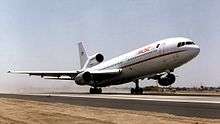
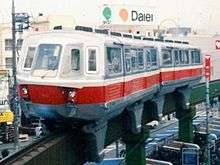

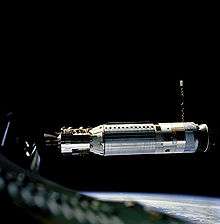
A partial listing of aircraft and other vehicles produced by Lockheed.
Airliners and civil transports
- Lockheed Vega
- Lockheed Model 10 Electra
- Lockheed Model 12 Electra Junior
- Lockheed Model 14 Super Electra
- Lockheed Model 18 Lodestar
- Lockheed Constellation, famous airliner
- Lockheed L-049 Constellation, first model of the Lockheed Constellation
- Lockheed L-649 Constellation, improved Lockheed Constellation
- Lockheed L-749 Constellation, further improved Lockheed Constellation
- Lockheed L-1049 Super Constellation, largest produced model of the Lockheed Constellation
- Lockheed L-1649 Starliner, last model of the Lockheed Constellation
- Lockheed Saturn
- Lockheed L-188 Electra
- Lockheed JetStar, business jet
- L-1011 TriStar, wide-body airliner
- Odakyu Type 500 monorail for Mukōgaoka-Yūen Monorail (as Nihon-Lockheed Monorail, with Kawasaki Heavy Industries), in service from 1966 to 2001
- Himeji Monorail Type 100/200 (as Nihon-Lockheed Monorail, with Kawasaki Heavy Industries), in service from 1966 to 1974
Military transports
- Lockheed C-69/Lockheed C-121 Constellation, military transport versions of the Constellation
- YC-121F Constellation, experimental turboprop version
- Lockheed R6V Constitution, large transport aircraft
- Lockheed C-130 Hercules, medium combat transport (AC-130 gunship) (other variants)
- Lockheed C-141 Starlifter, long-range jet transport
- Lockheed C-5 Galaxy, heavy transport
- Flatbed, military transport project, canceled
Fighters
- Lockheed P-38 Lightning, twin-engine propeller fighter
- Lockheed P-80 Shooting Star, the United States Air Force's first operational jet fighter
- Lockheed T-33 Shooting Star, trainer jet
- Lockheed F-94 Starfire, all-weather fighter'
- Lockheed F-104 Starfighter, interceptor and later a multi-mission fighter, the 'missile with a man in it'
- Lockheed F-117 Nighthawk, stealth fighter attack aircraft
- General Dynamics F-16 Fighting Falcon, multirole fighter (Originally General Dynamics)
- Lockheed YF-22, air superiority stealth fighter
Patrol and reconnaissance
- Lockheed Hudson, maritime patrol/bomber
- PV-1 Ventura and PV-2 Harpoon, Maritime patrol/bomber
- PO-1W/WV-1 Constellation, AWACS version of the Constellation
- EC-121/WV-2 Warning Star, AWACS version of the Super Constellation
- Lockheed P-2 Neptune, maritime patrol
- Lockheed P-3 Orion, ASW patrol
- Lockheed U-2/TR-1, reconnaissance
- Lockheed SR-71 Blackbird, reconnaissance (A-12) (M-21) (YF-12)
- Lockheed S-3 Viking, patrol/attack
- YO-3A Quiet Star
Helicopters
- Lockheed CL-475, rigid-rotor helicopter
- XH-51A/B (Lockheed CL-595/Model 286), compound helicopter testbed
- Lockheed AH-56 Cheyenne, prototype attack compound helicopter
Missiles
Space technology
Sea vessels
See also
References
Notes
- ↑ Lockheed Corporation 10-K Annual Report Filing to the U.S. Securities and Exchange Commission
- ↑ "Lockheed Martin History". Lockheed Martin. Retrieved 2018-06-21.
- ↑ "Allan Haines Lockheed". Davis-Monthan Airfield Register. Retrieved 2010-01-17.
- ↑ "Lockheed, Allan Haines - National Aviation Hall of Fame". National Aviation Hall of Fame. Retrieved 2018-06-22.
- ↑ Parker 2013, p. 59.
- ↑ Herman 2012, pp. 85–86.
- ↑ Parker 2013, pp. 59, 71.
- ↑ Lockheed was delivering airplanes to Japan until May 1939.
- 1 2 Parker 2013, pp. 59-76.
- ↑ Herman 2012, p. 287.
- ↑ Parker 2013, pp. 59, 75–76.
- ↑ "World War II-Lockheed Burbank Aircraft Plant Camouflage." Amazing Posts, August 16, 2008.
- ↑ "How to Hide an Airplane Factory." Archived January 1, 2014, at the Wayback Machine. Thinkorthwim.com, August 19, 2007; retrieved September 30, 2011.
- ↑ "California Becomes a Giant Movie Set." Flat Rock, July 16, 2009.
- ↑ Peck and Scherer 1962, p. 619.
- ↑ Time Magazine, January 14, 1946.
- ↑ Baugher, Joe. "Lockheed P-80/F-80 Shooting Star." USAF Fighter, July 16, 1999. Retrieved: June 11, 2011.
- ↑ Stanton, T.P. "An Assessment of Lockheed Aircraft Corporation and the Emergency Loan Guarantee Act." U.S. Naval Postgraduate School, 1977.
- ↑ "Fragen zur politischen Biographie". Franz Josef Strauß (in German). Archived from the original on January 21, 2010.
- ↑ "Monday, August 18, 1975." Time magazine, August 18, 1975. Retrieved: September 30, 2011.
- ↑ Lockheed F-104 Starfighter at militaryfactory.com, Retrieved August 29, 2009
- ↑ "In 1962 Lockheed Corporation made the deal of the century by selling West Germany three hundred and fifty F-104 Starfighters..." Paul Emil Erdman, The last days of America: G.K. Hall, 1982 ISBN 0-8161-3349-2, p 24
- ↑ Lindsey, Robert (February 14, 1976). "2 Lockheed Officials Quit; Haack Is Interim Chairman". N.Y. Times.
- ↑ Hayes, Thomas. "Lockheed Fends Off Simmons", The New York Times, March 19, 1991.
- ↑ Richard W. Stevenson, "Simmons Is Considering Possible Lockheed Bid", The New York Times, February 1990.
- ↑ "Simmons to Lift Lockheed Stake." The New York Times, November 22, 1989.
- ↑ History of Burbank, The Changing Face of the City Archived December 27, 2011, at the Wayback Machine., City of Burbank Website,
- ↑ Francillon 1987, pp. 47–49.
Bibliography
- Allen, Richard Sanders. Revolution In The Sky. Brattleboro, Vermont: The Stephen Greene Press, 1964. LOC 63-20452.
- Baker, Nicholson. Human Smoke: The Beginnings of World War II, the End of Civilization. New York: Simon & Schuster, 2008. ISBN 978-1-41657-246-6.
- Boyne, Walter J. Beyond the Horizons: The Lockheed Story. New York: St. Martin's Press, 1998. ISBN 0-312-19237-1.
- Francillon, René J. Lockheed Aircraft since 1913. Annapolis, Maryland: Naval Institute Press, 1987. ISBN 978-0-87021-897-2.
- Herman, Arthur. Freedom's Forge: How American Business Produced Victory in World War II. New York: Random House, 2012. ISBN 978-1-4000-6964-4.
- Miller, Jay. Lockheed Martin's Skunk Works: The Official History, Updated Edition. Arlington, Texas: Aerofax, 1995. ISBN 1-85780-037-0.
- Parker, Dana T. Building Victory: Aircraft Manufacturing in the Los Angeles Area in World War II. Cypress, California: Dana T. Parker Books, 2013. ISBN 978-0-9897906-0-4.
- Peck, Merton J. and Frederic M. Scherer. The Weapons Acquisition Process: An Economic Analysis. Boston: Harvard Business School, 1962.
External links
| Wikimedia Commons has media related to Lockheed. |
- Allan and Malcolm Loughead (Lockheed) Their Early Lives in the Santa Cruz Mountains
- Lockheed Brothers from PBS
- The Jetmakers
- Kakuei Tanaka. "Chapter 4 The Lockheed Scandal" A political biography of modern Japan. (The Kodama organization, a Yakuza gang, got mixed up in this scandal.)
- Lockheed history on lockheedmartin.com
- Camouflaged plant during WW II
- Lockheed Monorail by Kim Pedersen
- Lockheed Aircraft Corporation Photographs from the Atlanta History Center
